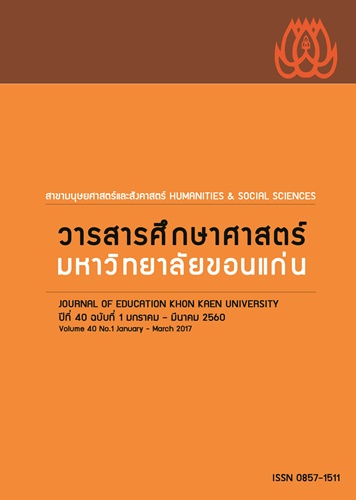การพัฒนาความสัมพันธ์ในการเคลื่อนไหวของบุคคลที่มีภาวะออทิสซึม โดยการใช้ตารางสามเหลี่ยม
Main Article Content
บทคัดย่อ
การวิจัยครั้งนี้มีวัตถุประสงค์ 1) เพื่อสร้างแบบฝึกตารางสามเหลี่ยม สำหรับบุคคลที่มีภาวะออทิสซึม 2) เพื่อศึกษาผลของความสัมพันธ์ในการเคลื่อนไหวของบุคคลที่มีภาวะออทิสซึม จากการใช้ตารางสามเหลี่ยม โดยกลุ่มตัวอย่างในครั้งนี้คือ นักเรียนออทิสติกที่กำลังศึกษาที่โรงเรียนสาธิตมหาวิทยาลัยขอนแก่น (ศูนย์วิจัยและพัฒนาการจัดการศึกษาพิเศษแบบเรียนรวมสำหรับเด็กออทิสติก) คณะศึกษาศาสตร์ มหาวิทยาลัยขอนแก่น จังหวัดขอนแก่น จำนวน 3 คน ซึ่งมีอายุ 10-12 ปี โดยวิธีการสุ่มแบบเฉพาะเจาะจงเครื่องมือที่ใช้ในการวิจัยครั้งนี้คือ ตารางสามเหลี่ยมและแบบฝึกตารางสามเหลี่ยมที่ผู้วิจัยสร้างขึ้น โดยใช้แนวทางการวิจัยแบบกลุ่มตัวอย่างเดี่ยว
จากแบบบันทึกพฤติกรรมและแบบบันทึกความสัมพันธ์ในการเคลื่อนไหว หลังการฝึกตามแบบฝึกตารางสามเหลี่ยมจำนวน 22 แบบฝึก เป็นเวลา 10 สัปดาห์, สัปดาห์ละ 3 ครั้ง ทำให้กลุ่มตัวอย่างทั้ง 3 คน มีความสัมพันธ์ในการเคลื่อนไหวดีขึ้นกว่าก่อนการฝึก นอกจากนี้ในช่วงระหว่างการฝึก กลุ่มตัวอย่างทั้ง 3 คนมีการพัฒนาปฏิกิริยาการรับรู้สั่งงานของสมองที่เร็วยิ่งขึ้น เกิดการพัฒนาทักษะการคิด จนเกิดสมาธิและจดจ่ออยู่กับรูปแบบการเคลื่อนไหวต่าง ๆ ยาวนานขึ้น เพิ่มความสามารถในการรับรู้ จดจำได้เร็วขึ้น และควบคุมทักษะการเคลื่อนไหวอย่างมีประสิทธิภาพ ในการฝึกแบบฝึกตารางสามเหลี่ยม
ผลการวิจัยพบว่า ในการสร้างแบบฝึกตารางสามเหลี่ยมนั้น ผู้วิจัยได้สร้างแบบฝึกจากทักษะที่ง่ายไปหายาก โดยมีขั้นตอนจากการเดินก่อนแล้วค่อยกระโดด จากทิศทางตรงแล้วค่อยเลี้ยว จากช้าไปเร็ว เพื่อให้เกิดการสร้างความสัมพันธ์ในการเคลื่อนไหว ซึ่งมีความเหมาะสมกับลักษณะการเรียนรู้ของกลุ่มตัวอย่างนักเรียน ออทิสติก โดยส่งผลให้เกิดการเรียนรู้ที่หลากหลายและมีการพัฒนาความสัมพันธ์ในการเคลื่อนไหวที่ดีเป็นปกติ
Abstract
The purposes of this study were (1) to construct a triangular area movement task for autistic children, and (2) to study the effect of using a triangular area movement task during training to improve movement coordination in autistic children. The samples selected were 3 students with autism aged between 10-12 years who are studying at Khon Kaen University Demonstration School, Special Education Division, Faculty of Education, Khon Kaen University.
A specific randomize sampling approach was used in this study. The instruments were triangular area and triangular area movement task which using Single subject design.
From Behavior record and A record of coordination in motion. After training with the triangular area movement task in a total of 22 movement patterns 3 times a week for 10 weeks, the samples have improved movement coordination. During the training, the three samples also developed perceptual-motor reaction of the brain. They have improved thinking skills so that they were able to concentrate on their movement patterns. Moreover, they were able to perceive, memorize and control their movements efficiently in the triangular area movement task training.
The results showed that in constructing the triangular area movement task, the researchers ranged the training from easy to hard movement skills, for example, from walking to jumping, from walking straight ahead to turning, from slow to fast, in order to develop movement coordination. This is appropriate to the learning style of autistic children and resulted in the learning of various skills and the development of good movement coordination.
Keywords: movement coordination, triangular area movement task

